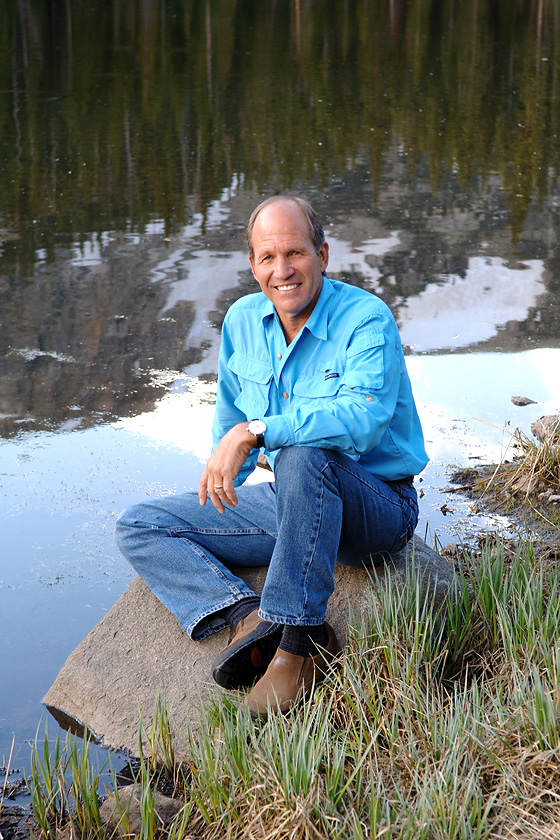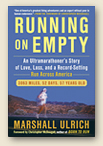|
 What do you mean by the book's title, “Running on Empty”? What do you mean by the book's title, “Running on Empty”?

It refers to a couple of things. First, feeling emptied out is a familiar state to anyone who runs long distances. It’s a place where you feel like there’s nothing left, no more energy, or sanity, or willingness to keep going—but you go on anyway. You keep putting one foot in front of the other despite the emptiness, and you discover that there’s great strength even in that zone of “no more.” Second, it also refers to emotional emptiness. In the book, I describe some of the times in my past when I felt incredibly alone, times when I thought the only person I could depend upon was myself. So the book is about running, but it's also about relationships.
Why did you write this book?

After my 2008 run across the United States, I felt that I had enough life experience to qualify me, perhaps, to write a book. In addition to my personal revelations on the road, I wanted to share some of the history of ultrarunning, which I find fascinating. I wanted to help reintroduce America to Americans by telling some of the history of our country, too, highlighting some interesting places we saw and some stories about people we met during the experience.
But, even more than that, I thought I might have some “lessons learned along the way” that could be of interest and help to others. Not that I know it all! Certainly not. But I’ve faced down a few challenges, inflicted some unintentional pain upon others, and endured some suffering, both physical and emotional, throughout my life. People can relate to all of that, even if they don’t pursue these extremes of athleticism—they go through challenges, pain, and suffering, too—and I now think, with all of my experiences, I have something to share that’s worth reading.
Besides, what happened during the transcontinental run was just too wild—unexpected, scary, infuriating, heartwarming, and uplifting—to keep it to myself.
What made you decide to run across the United States?

This was the last item on my extreme to-do list. I’d been running since 1980, ultrarunning (competing in races longer than a marathon) since 1986, and adventure racing since 1995; and I’d climbed the Seven Summits between 2002 and 2005, including Mount Everest in 2004. Everest was a childhood dream, and I’d been thinking of doing the transcontinental run since the ’90s. I feel fortunate to have completed both before my sixtieth birthday.
The run was an attempt on a world record set by Frank Giannino back in 1980—coincidentally, around the same time I started running, and Frank and I are close to the same age. Frank was 28 when he set the record; I wanted to give it a go when I was a card-carrying member of AARP. I love shaking up people’s ideas of what’s possible and showing that the only limits are in your mind. Who says a 57-year-old man can’t run across the country?
You didn’t write the book while you were in pursuit of the record but instead about a year later. How did you remember all that had happened?

We did have some documentation from the run, though what really helped was when my wife and I retraced my steps by taking a car trip in April of 2009. Heather and I drove the entire route, and this trip conjured a wide range of memories and emotions. Both of us kept journals during the trip, remembering what had happened the previous fall. These formed the basis for the outline of the book and they made me realize, to some extent, the depth and breadth of the entire experience, what I’d learned, and how it fit into my life as a whole.
The book took shape around the geographical landmarks, my emotional landscape, and even the weather. I noticed poetic echoes between what I’d experienced on the inside and what the environment had shown me on the outside, like the purgation of the early part of the run while we were in the arid desert, the downpour of rain during some days when I was feeling an acute sense of loss and was often in tears, and the snap of cold after what I thought was a friend’s betrayal.
So your memory served you well?

Mostly. Since I hadn’t written anything during the run itself, it was amazing to me the level of detail I was able to recall months later as I journaled and then as the writing began. I remembered entire conversations, people’s clothes, kind gestures, elevation gains and losses, turns in the road, architectural details of the buildings I’d passed. What also surprised me was what I couldn’t remember, or what I remembered incorrectly. Some of the details of my injuries had become fuzzy, as had many of my emotional reactions to what had happened. Thank goodness my wife is a stickler for detail, has great recall and a knack for research, as well as had access to a log that the crew kept, and double-checked every fact she could.
She also helped me conduct a deep and raw review of my entire life, warts and all. Facing down some of my demons, and many of my faults, was a scary thing to do. Revisiting my feelings, reassessing them, helped me put what really happened into the book in a way that is as accurate as I could make it. |


 What do you mean by the book's title, “Running on Empty”?
What do you mean by the book's title, “Running on Empty”?